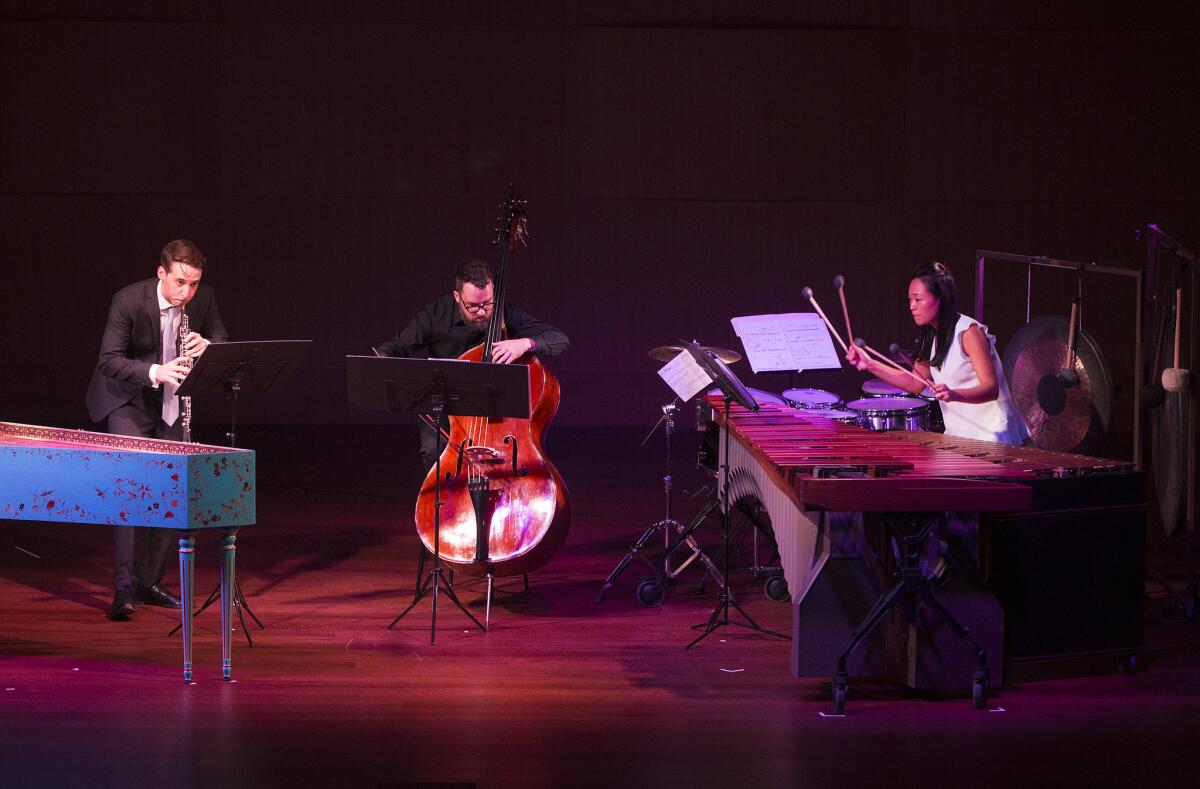Review: Bach forever! Camerata Pacifica enters the fray

There can be no escaping J.S. Bach. He inevitably tops surveys of the world’s greatest composers. An enterprising scholar should be able to write a book-length study of Bach’s influence on the musical life of any single year since Bach died in 1750.
In 2016, that’s an easy task. Three days after the U.S. presidential election, the cellist Johannes Moser dedicated a sad Bach sarabande to Hillary Clinton and to the memory of Leonard Cohen for his encore at a Los Angeles Philharmonic concert. A new recording by another venturesome cellist, Matt Haimovitz, pairs six new pieces by the likes of Philip Glass and the jazz pianist and composer Vijay Iyer with the preludes from the Bach cello suites. Violinist Jennifer Koh (who, it was announced Thursday, will premiere a concerto by Iyer at the Ojai Music Festival in June) did something similar recently with her Bach Project.
Wednesday night, it was Camerata Pacifica’s turn to enter into the Bachian fray with a program at the Huntington Library in San Marino that will repeat in downtown L.A., Ventura and Santa Barbara. Bach contended with modern music that may or may not have its roots in the Baroque composer — Bach so infuses everything that it can be hard to tell. Indeed, it was the aggressive avoidance of Bach that made Elliott Carter’s 1952 Sonata for Flute, Oboe, Cello and Harpsichord of particular interest. That was also true, if in a less aggressive way, with “Les Citations” by French composer and close Carter contemporary Henri Dutilleux.
In more recent works for cello and marimba by two of the hottest young New York composers, Caroline Shaw and Andy Akiho, Bach may not have been obvious, but he was certainly welcome to a party where every style is supposed to get along.
Still, the Carter was the biggest deal. Flutist Adrian Spence, the artistic director of the series, introduced it by jovially explaining why difficult music is something we often love without realizing it, so why worry?
A lot always goes on in Carter, a composer who took great pleasure in the multiplicity of life. (He led a particularly long and productive one, dying in 2012 just before his 104th birthday.) Carter liked to note that people-watching on Fifth Avenue happens to be an exercise in taking a lot in instantaneously, and later in life he was always far more excited by the streets of his present, with cars, than reminiscing about the horse-and-buggy boulevards of his childhood.
The key to understanding the jumble of his Sonata, and its tenuous relationship to Bach, is just that. Carter was intrigued by the modern harpsichords that became briefly popular after World War II, before they became obsolete with the rage for historically minded performances of Baroque music. His Sonata begins with a shock of steely sound from what is supposed to be a noisy harpsichord, and the job of the flute, oboe and cello is to react to that, get their sounds to reinforce the overtones of the harpsichord.
The 18th century has nothing to do with this, although in the last of the three movements, Carter fractures an old dance rhythm Bach might have used. But where Bach mainly comes in is that Carter was, like Bach, the greatest contrapuntalist of his time.
Dutilleux’s “Les Citations” for harpsichord, bass and percussion, cites others: Benjamin Britten in the first movement, French composers through the centuries in the second. It is gentle music, Bachian only in the loving attention to detail.
Camerata Pacifica used these two pieces as the thick filling of musical sandwich on Bach bread. The top layer was made up of a short two-part invention and a trio sonata; the Bach bread underneath was the Chromatic Fantasy and Fugue in D Minor for harpsichord. The hourlong first half was given without break between the pieces (other than for brief set-ups when necessary) and played in a darkened hall. The audience was asked to hold its applause.
That added a touch too much severity and gloom. The shock of the new — or, in the case of Bach’s radical harmonies in the solo harpsichord pieces, the shock of the old — was further mitigated by the fact that the harpsichord used wasn’t one of the big, unfashionable modern instruments. Unamplified, it didn’t have enough volume to make the proper effect. Nor was harpsichordist Paolo Bordignon a dramatic player.
The second half was meant to be more entertaining. Shaw’s “Boris Kerner” for cello and flower pots and Akiho’s “21” for marimba and cello are lively, engaging pieces. Where’s the Bach in the post-Minimalist repetitions and elements of pop and jazz? Shaw likes Baroque forms and cute surprises, although her flower pots aren’t all that interesting sonically. Akiho finds the grooves. In between these, Japanese composer Naoko Hishinuma’s “On a Full Moon Night” for flute and percussion offered something dreamy.
In these cellist Ani Aznavoorian and percussionist Ji Hye Jung were dazzling. In fact, the most strikingly “modern” Bach turned out to be a fugue from a Bach solo violin sonata that Jung transcribed for marimba.
So will 2017 be, like every other, another big Bach year? Of course. Even Donald Trump can’t change that.
------------
Camerata Pacifica
When: 8 p.m. Thursday at Zipper Hall, Los Angeles; 7:30 p.m. Friday at Hahn Hall in Santa Barbara, 3 p.m. Sunday at Temple Beth Torah in Ventura
Tickets: $50-$56
Information: (805) 884-8410, cameratapacifica.org
More to Read
The biggest entertainment stories
Get our big stories about Hollywood, film, television, music, arts, culture and more right in your inbox as soon as they publish.
You may occasionally receive promotional content from the Los Angeles Times.











